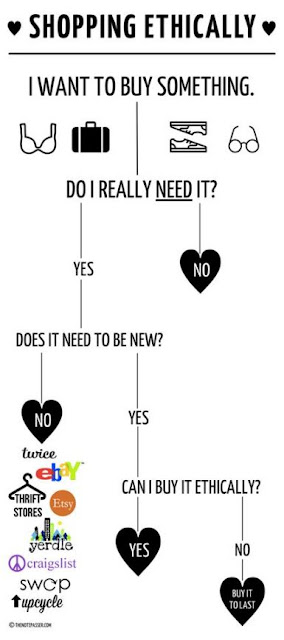"This extended break from shopping seemed to work as a circuit breaker, and gave me a fresh perspective."
This quote, from a story on The Age today, perfectly sums up the effect of my own almost year-long break from shopping (28 days to go!).
Before the ban, I was on the fast fashion treadmill and never paused to think about the ripple effects of my purchases: is the person who made it paid enough to live on (probably not)? Did the manufacturing process pollute the environment (quite likely)? What will happen to it when I get rid of it (the op shop can deal with that)? I just enjoyed the thrill of having something new to wear while ignoring the growing feeling that I was amassing a wardrobe of clothes I hardly ever wore.
Eventually that feeling got too loud too ignore and that's when my no-shopping challenge was born. Unlike the Jayne who wrote the above article, I only started investigating the ethics of clothes shopping after I stopped shopping, whereas she kind of defaulted to not shopping because of her interest in eco-style.
We both followed the path to the more broader minimalist movement though. Conscious consumerism and minimalism go hand in hand. (I encountered The Minimalists along the way too, but kicked them to the kerb without watching their documentary because of the odour of white male privilege emanating from some of their stuff.)
We both followed the path to the more broader minimalist movement though. Conscious consumerism and minimalism go hand in hand. (I encountered The Minimalists along the way too, but kicked them to the kerb without watching their documentary because of the odour of white male privilege emanating from some of their stuff.)
I don't know if it's just because I've been paying more attention, but it seems like more and more stories about shopping bans, ethical consumption (especially of fashion) and minimalism have been appearing in the mainstream media in the past 11 months. I have been paying more attention, but my feeling is it's the latter - conscious consumerism is so hot right now. Or at least hotter than it used to be. Maybe it's the Konmari effect.
But while these stories are making their way into mainstream media, the movements themselves are still far from mainstream, and I doubt they ever will be because capitalism. It's all about constant growth, and not the personal kind that involves getting in touch with what we really need.
But while these stories are making their way into mainstream media, the movements themselves are still far from mainstream, and I doubt they ever will be because capitalism. It's all about constant growth, and not the personal kind that involves getting in touch with what we really need.














